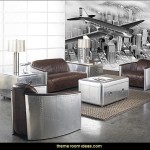How To Decorate A Small Modern Living Room
Decorating a small modern living room presents a unique set of challenges and opportunities. Maximizing space, maintaining functionality, and creating an aesthetically pleasing environment require careful planning and execution. This article outlines key principles and strategies for effectively decorating a small living room in a modern style.
Maximize Vertical Space
In a small living room, floor space is a premium. Therefore, leveraging vertical space is crucial for both storage and visual appeal. Strategies for maximizing vertical space include incorporating tall shelving units, wall-mounted cabinets, and strategic artwork placement.
Tall shelving units provide ample storage for books, decorative objects, and entertainment equipment. Opting for open shelving can prevent the space from feeling closed off, while incorporating baskets and containers can help conceal clutter and maintain a tidy appearance. When selecting shelving, consider units that extend nearly to the ceiling to draw the eye upward, creating the illusion of greater height. Choose lighter colored shelves to avoid the feeling of heaviness.
Wall-mounted cabinets offer a discreet storage solution, particularly for items that are not frequently used. These cabinets can be installed at varying heights to create visual interest and cater to specific storage needs. Consider using cabinets with mirrored doors to reflect light and further enhance the sense of space. Opt for minimalist designs with clean lines to align with the modern aesthetic.
Artwork placement can significantly impact the perceived size of a room. Hanging artwork higher on the wall than usual can draw the eye upwards, making the ceiling appear taller. A single, large piece of art can create a focal point without overwhelming the space, while a carefully curated gallery wall can add personality and visual interest. Ensure that the artwork is proportionally appropriate for the size of the room; overly large pieces may feel imposing in a small space. Consider using slim frames to minimize visual bulk.
Mirrors are invaluable for expanding the perceived space in a small living room. A large mirror placed strategically can reflect light and create the illusion of depth. Ideal locations for mirrors include opposite windows or along walls that appear visually compressed. Consider a leaning floor mirror for a casual, modern look, or a wall-mounted mirror with a sleek frame to complement the room's design. The shape of the mirror can also contribute to the overall aesthetic; rectangular mirrors can elongate the space, while round mirrors can soften the lines of the room.
Employ Minimalist Furniture and Color Palette
Selecting the right furniture and color palette is paramount in a small modern living room. A minimalist approach, characterized by clean lines, simple shapes, and a limited color scheme, can prevent the space from feeling cluttered and overwhelming. Consider multi-functional furniture to optimize space and functionality.
When choosing furniture, prioritize pieces that are appropriately scaled for the room. Avoid oversized sofas or bulky armchairs that can dominate the space. Opt for a smaller sofa or loveseat with a streamlined silhouette. Consider sectionals with modular components that can be rearranged to suit different needs. Look for furniture with exposed legs, as this allows light to pass underneath, creating a sense of openness. Furniture with built-in storage, such as ottomans with hidden compartments or sofas with drawers, can further enhance functionality.
A neutral color palette is an effective strategy for creating a sense of spaciousness and tranquility. Light colors, such as white, cream, and pale gray, reflect light and make the room feel larger. Introduce subtle pops of color through accessories like cushions, throws, and artwork. Maintaining a consistent color scheme throughout the room creates a cohesive and harmonious look. Avoid using excessively dark or vibrant colors, as these can visually shrink the space.
Consider incorporating texture to add depth and interest to the neutral color palette. Incorporate materials like linen, wool, and wood to create a tactile experience. Use textured cushions, throws, and rugs to add warmth and comfort to the room. Adding subtle patterns, such as geometric designs or simple stripes, can add visual interest without overwhelming the space.
Lighting plays a crucial role in creating a welcoming and functional living room. Maximize natural light by keeping windows unobstructed. Use sheer curtains or blinds to allow light to filter through while maintaining privacy. Supplement natural light with a combination of ambient, task, and accent lighting. Ambient lighting provides overall illumination, task lighting illuminates specific areas for reading or working, and accent lighting highlights artwork or architectural features. Opt for LED bulbs, which are energy-efficient and provide a bright, clean light. Consider using dimmers to adjust the lighting levels to suit different moods and activities.
Prioritize Functionality and Organization
In a small living room, every piece of furniture and decorative item should serve a purpose. Prioritizing functionality and organization is essential for maintaining a clutter-free and livable space. Effective storage solutions, multi-functional furniture, and careful space planning are key components of a well-organized small living room.
Storage solutions should be integrated seamlessly into the design of the room. Ottomans with hidden storage compartments, coffee tables with built-in drawers, and shelving units with baskets and containers are all excellent options for concealing clutter. Consider using wall-mounted organizers to keep small items like keys, mail, and remote controls readily accessible. Regularly declutter the room to eliminate items that are no longer needed or used. Implement a system for organizing belongings and stick to it consistently.
Multi-functional furniture is a valuable asset in a small living room. A sofa bed can provide additional sleeping space for guests, while a coffee table with a lift-top can serve as a dining table or workspace. Nesting tables can be pulled out when needed and stored away to save space when not in use. Consider using a room divider to create separate zones within the living room, such as a reading nook or a home office. A folding screen or a curtain can be used to create privacy when needed without taking up permanent floor space.
Careful space planning is crucial for maximizing the usability of a small living room. Create a floor plan to visualize the layout of the furniture and ensure that there is adequate circulation space. Consider the flow of traffic through the room and arrange furniture accordingly. Avoid blocking pathways or creating bottlenecks. Use rugs to define different zones within the room and anchor the furniture groupings. An area rug can add warmth, texture, and visual interest to the space while also delineating the seating area.
The arrangement of furniture should promote conversation and interaction. Place the sofa and chairs facing each other to create a comfortable seating area. Consider using a coffee table as a central point for gathering and placing drinks or snacks. Ensure that there is adequate lighting for reading, working, or entertaining. Use table lamps, floor lamps, and overhead lighting to create a well-lit and inviting atmosphere. Strategically position lighting fixtures to highlight artwork, architectural features, or decorative objects. Consider using smart lighting systems that allow you to control the lighting levels and color temperature with your smartphone or voice commands.
Incorporating personal touches can transform a small living room into a warm and inviting space that reflects personal style. Displaying cherished photographs, artwork, and decorative objects can add character and personality to the room. Curate a collection of items that are meaningful and aesthetically pleasing. Avoid cluttering the space with excessive decorations. Use plants to add life and freshness to the room. Choose plants that are appropriate for the lighting conditions and that require minimal maintenance. Consider using vertical planters to save space and create a green wall. Incorporating natural elements, such as wood, stone, and plants, can bring warmth and tranquility to the living room.
By applying these strategies, decorating a small modern living room can be a rewarding experience. Careful planning, thoughtful furniture selection, and a commitment to organization will result in a functional, stylish, and inviting space.
:max_bytes(150000):strip_icc()/241791572_212003384294928_1925123565378044744_n-3dceead11099472ca283f51eea10a0f3.jpg?strip=all)
52 Small Living Room Ideas To Maximize Space And Style

44 Best Small Living Room Ideas How To Decorate A

How To Decorate A Small Living Room Forbes Home

10 Modern Living Room Design Ideas Designcafe
:max_bytes(150000):strip_icc()/154844841_1913837928767303_4703053855314656226_n-7776f09f3d67417caf5a7bd062c1acd1.jpg?strip=all)
52 Small Living Room Ideas To Maximize Space And Style

Top 10 Small Living Room Ideas For Your Home
:strip_icc()/cdn.cliqueinc.com__cache__posts__277814__how-to-decorate-a-small-living-room-277814-1553625854515-image.700x0c-af6a3d746c314482aec3f57802599642.jpg?strip=all)
How To Decorate A Small Living Room In 6 Steps

Best Small Living Room Design Ideas Decor Inspiration

38 Small Yet Super Cozy Living Room Designs Design Decor Rooms

10 Stunning Small Living Room Ideas To Maximize Space
Related Posts







